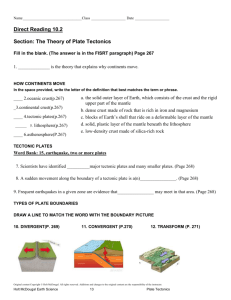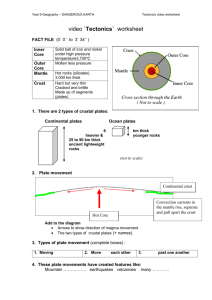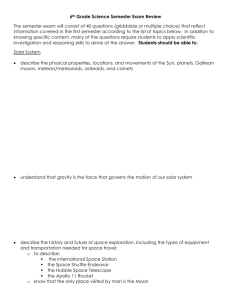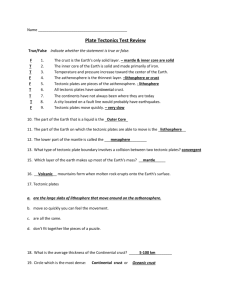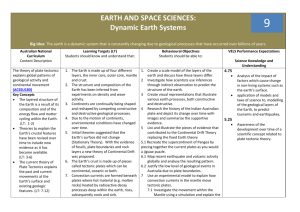Source*s of Earth Energy
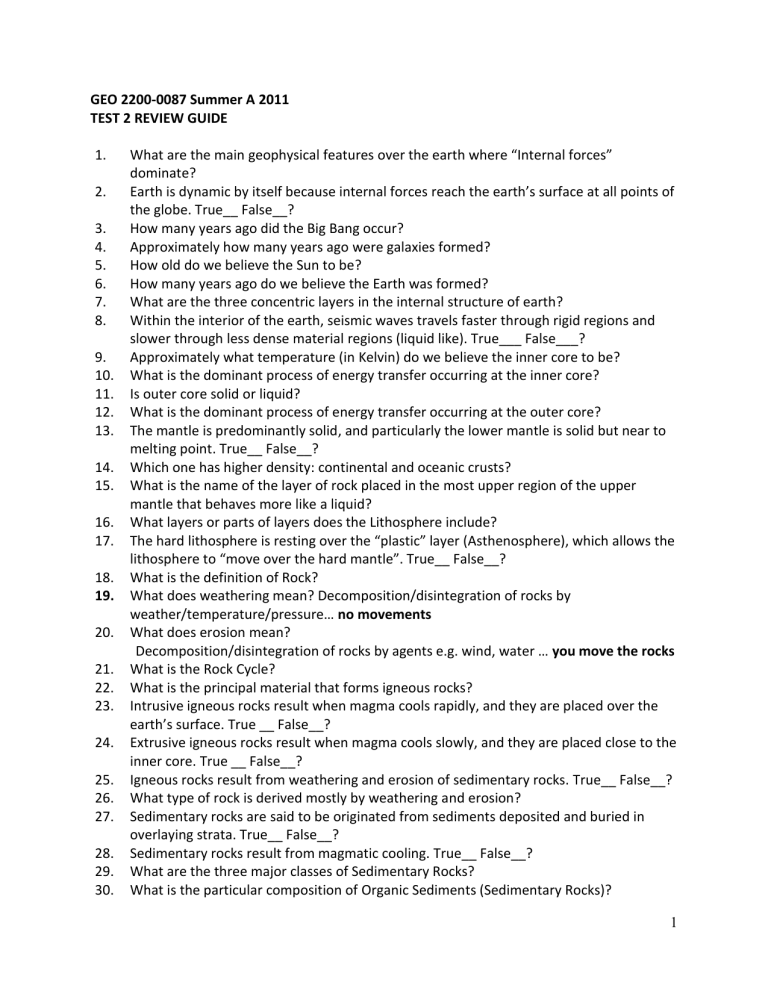
GEO 2200-0087 Summer A 2011
TEST 2 REVIEW GUIDE
1.
What are the main geophysical features over the earth where “Internal forces” dominate?
2.
Earth is dynamic by itself because internal forces reach the earth’s surface at all points of the globe. True__ False__?
3.
How many years ago did the Big Bang occur?
4.
Approximately how many years ago were galaxies formed?
5.
How old do we believe the Sun to be?
6.
How many years ago do we believe the Earth was formed?
7.
What are the three concentric layers in the internal structure of earth?
8.
Within the interior of the earth, seismic waves travels faster through rigid regions and slower through less dense material regions (liquid like). True___ False___?
9.
Approximately what temperature (in Kelvin) do we believe the inner core to be?
10.
What is the dominant process of energy transfer occurring at the inner core?
11.
Is outer core solid or liquid?
12.
What is the dominant process of energy transfer occurring at the outer core?
13.
The mantle is predominantly solid, and particularly the lower mantle is solid but near to melting point. True__ False__?
14.
Which one has higher density: continental and oceanic crusts?
15.
What is the name of the layer of rock placed in the most upper region of the upper mantle that behaves more like a liquid?
16.
What layers or parts of layers does the Lithosphere include?
17.
The hard lithosphere is resting over the “plastic” layer (Asthenosphere), which allows the lithosphere to “move over the hard mantle”. True__ False__?
18.
What is the definition of Rock?
19.
What does weathering mean? Decomposition/disintegration of rocks by weather/temperature/pressure… no movements
20.
What does erosion mean?
Decomposition/disintegration of rocks by agents e.g. wind, water … you move the rocks
21.
What is the Rock Cycle?
22.
What is the principal material that forms igneous rocks?
23.
Intrusive igneous rocks result when magma cools rapidly, and they are placed over the earth’s surface. True __ False__?
24.
Extrusive igneous rocks result when magma cools slowly, and they are placed close to the inner core. True __ False__?
25.
Igneous rocks result from weathering and erosion of sedimentary rocks. True__ False__?
26.
What type of rock is derived mostly by weathering and erosion?
27.
Sedimentary rocks are said to be originated from sediments deposited and buried in overlaying strata. True__ False__?
28.
Sedimentary rocks result from magmatic cooling. True__ False__?
29.
What are the three major classes of Sedimentary Rocks?
30.
What is the particular composition of Organic Sediments (Sedimentary Rocks)?
1
31.
What are the two principal processes to form Metamorphic rocks?
32.
What does Plate Tectonics refer to? Q.65
33.
At Divergent Boundaries new lithosphere is being formed. True__ False__?
34.
What is the main tectonic process occurring at divergent boundaries?
35.
The East African Rift Valley lies along a divergent plate boundary. True__ False__?
36.
On top of what type of tectonic boundary does the island of Iceland (middle of the North
Atlantic) lie?
37.
At convergent boundaries, lithosphere is being destructed. True__ False__?
38.
What are the three types of Convergent Boundaries?
39.
Which geophysical features are associated with a convergent plate boundaries?
40.
What type of tectonic plate boundary occurs at the western coast of South America?
Name the two tectonic plates.
41.
Which large mountain chain owes its origin to the collision of the South American and
Nazca tectonic plates?
42.
When a continental and an oceanic plate collide, which plate goes down beneath the other? Why?
43.
What are the geophysical features associated with the collision of two oceanic plates?
44.
Imagine “a transect” drawn from Japanese islands and South America (from northwest to southeast), what tectonic plates will you be including in the transect, and what type of boundaries will you find between those plates?
45.
In the same “imaginary transect” mentioned above, where can you find convergence boundary?
46.
In the same transect: where do you find divergent boundary? What is the name of that mid-oceanic ridge?
47.
What is the name of the mountain range that was formed from the Indian Plate colliding with the Eurasian plates?
48.
What is the name of the ocean that geologist say it existed between ancient India land mass and Asia?
49.
To which of the following present day continents do we believe that India was attached, about 250 million years ago?
50.
Himalaya Mountains were formed by continental-continental convergence. True ____
False ___
51.
What type of geophysical feature is the formation of Hawaiian Islands?
52.
Hawaiian Islands occur on the Pacific Plate and have been formed by a narrow stream of hot mantle that reaches earth’s crust, which produces volcano activity with no spreading of oceanic floor. True__ False__?
53.
From southeast to northwest along all Hawaiian Islands, where found the youngest volcanic rocks found?
54.
Hawaiian Islands, Japanese Islands, and Iceland have similar geologic formation: in all cases there is formation of continental crust. True__ False__?
55.
What are Transform Boundaries?
56.
Along what type of plate boundary does the San Andreas Fault, California, lie?
2
57.
What are the plates and boundary types of the tectonic activity occurring at western
United States?
58.
What is continental drift?
59.
What is epicenter?
60.
What is hypocenter?
61.
What is the Mercalli Scale?
62.
Richter scale measures quantitatively the amount of energy released by the quake.
True__ False__?
63.
The energy of an earthquake increase with distance from the epicenter. True__ False__?
64.
On what other features, besides magnitude, do earthquake’s effects depend?
65.
What is the main difference between the Continental Drift theory and the Plate Tectonics theory?
66.
What is hydrologic cycle?
67.
Approximately what is the total amount of water moving annually among the 3 storages as Global Flux?
68.
What are the inputs and outputs of water in the ocean store (in terms of percentage)?
69.
What are the inputs and outputs of water in the continent store (in terms of percentage)?
70.
What are the inputs and outputs of water in the atmosphere store? (in terms of percentage)
71.
What is the approximate residence time of water in the oceanic store?
72.
What is the approximate residence time of water in the continental store?
73.
What is the approximate residence time of water in the atmospheric store?
74.
Which are the three major water consumer districts in Florida?
75.
What ocean currents are there in the figure B, D, E, F, H. Are they cold or hot? Which direction are they moving?
3

